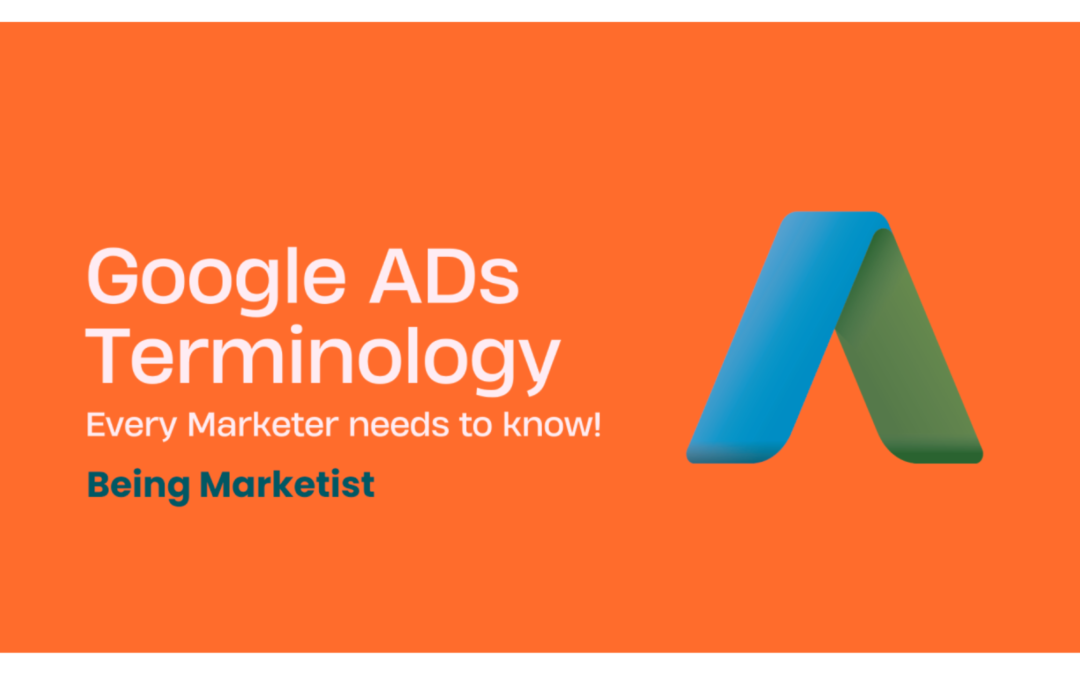Navigating the world of Google Ads can be daunting, especially the Google ad Terminology, when you’re confronted with a plethora of terms and concepts. From the basics of setting up your first campaign to the intricacies of optimizing your ads, understanding basic terms is crucial for success. This guide aims to simplify these terms, ensuring you can confidently create, manage, and optimize your Google Ads campaigns.
First and foremost, we’ll start with the foundational terms every advertiser needs to know. Then, we’ll transition into more advanced concepts and tools that can help you fine-tune your campaigns. Additionally, we’ll provide tips and best practices to avoid common pitfalls and maximize your return on investment.
By the end of this guide, you’ll not only be familiar with essential Google Ads terminology but also be equipped with the knowledge to implement effective advertising strategies. So, let’s dive in and demystify the language of Google Ads together!
Google Ads Terminology:

Ad Rank in Google Ads
Definition
Ad Rank is a Google ad Terminology that is a value that determines the position of your ad on the Google search results page. It’s calculated based on several factors, including your bid amount, the quality of your ads and landing page (Quality Score), the Ad Rank thresholds, the context of the search, and the expected impact of extensions and other ad formats.
Simple Explanation with Example:
Ad Rank in Google Ads is a Terminology like a ranking system for your ads. Imagine you and several other businesses want to show your ads to people searching for “best running shoes.” Each of you places a bid, which is the amount you’re willing to pay for a click on your ad. However, it’s not just about who bids the most. Ad Rank also considers how relevant and useful your ad and website are to the searcher. This is Quality Score.
For instance, let’s say your bid is $2 per click, and you have a high-quality score because your ad is very relevant, and your website is user-friendly and provides valuable information about running shoes. Another advertiser might bid $3 per click but has a lower quality score because their ad isn’t as relevant or their website isn’t as helpful.
Google Ads will take these factors into account and might place your ad higher on the search results page than the other advertiser’s ad, even though they bid more. This is because Google wants to provide the best experience for users by showing them the most relevant and useful ads.
Ad Rotation in Google Ads
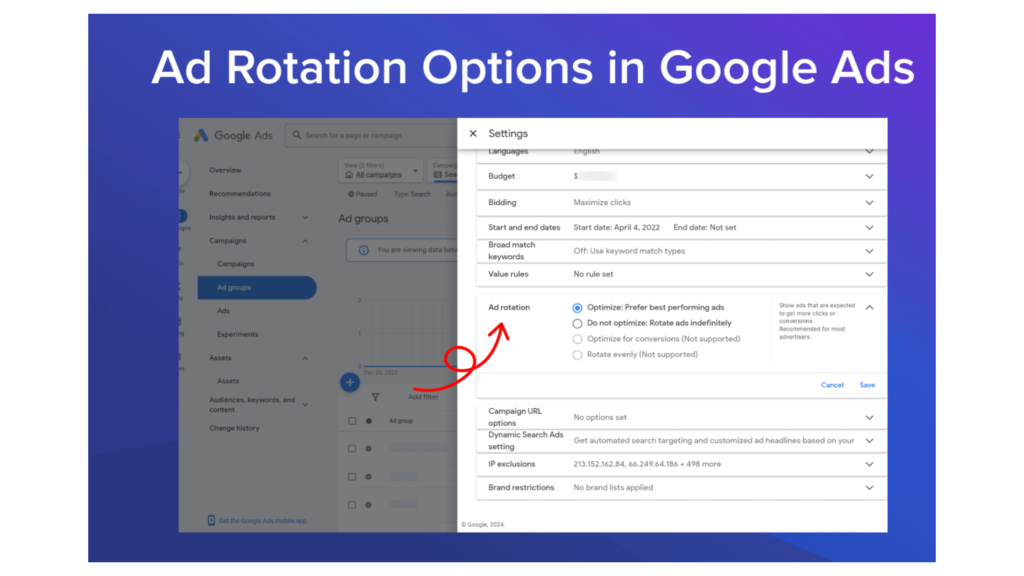
Definition:
Ad Rotation is a Google ad Terminology that is a setting in Google Ads that determines how frequently your different ads within the same ad group are shown in relation to one another. This setting can be used to optimize for clicks, conversions, or to rotate ads evenly for testing purposes.
Simple Explanation with Example:
Ad Rotation in Google Ads is like a way to manage how often each of your ads is shown. Imagine you have created multiple ads for the same product or service. Instead of showing just one ad all the time, Google Ads can rotate through all of them. This way, each ad gets to be displayed by users.
For instance, let’s say you have three different ads promoting your new line of organic skincare products. One ad focuses on the natural ingredients, another highlights customer testimonials, and the third offers a special discount. With Ad Rotation, Google can show each of these ads to different users at different times.
There are different ways you can set up Ad Rotation. If you choose to “optimize for clicks,” Google will show the ads that are most likely to get clicked on more often. If you “optimize for conversions,” it will prioritize showing ads that are most likely to lead to sales or other valuable actions on your website. You can also choose to “rotate ads evenly,” which means each ad gets roughly the same amount of exposure.
Ad Strength in Google Ads
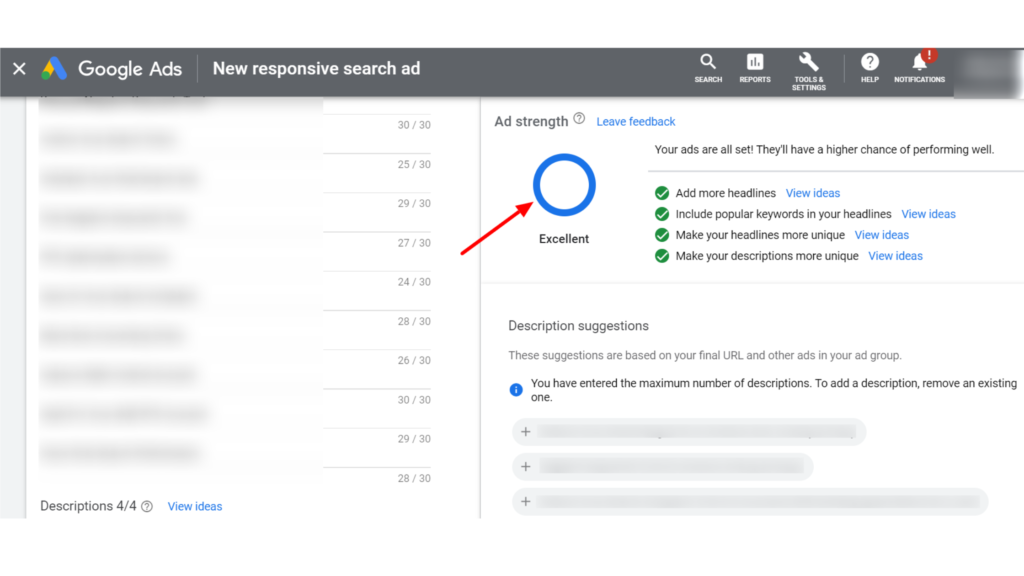
Definition:
Ad Strength is a Google ad Terminology that is a metric in Google Ads that evaluates the effectiveness and quality of your responsive search ads. It provides feedback on how well your ad assets (headlines, descriptions) are optimized to deliver the best performance and suggests improvements.
Simple Explanation with Example:
Ad Strength in Google Ads is like a report card for your ads. It tells you how well your ads are likely to perform based on their content and structure. When you create a responsive search ad, you can add multiple headlines and descriptions. Google Ads will then combine these elements in different ways to find the most effective combinations.
Imagine you are promoting a new line of eco-friendly clothing. You create several headlines, such as “Shop Sustainable Fashion,” “Eco-Friendly Clothes for a Better World,” and “Stylish and Sustainable Apparel.” You also write multiple descriptions like “Discover our latest collection of eco-friendly clothes,” “Join the movement towards sustainable fashion,” and “Shop stylish and sustainable outfits today.”
Ad Strength will analyze these combinations and give you a rating, such as “Poor,” “Average,” “Good,” or “Excellent.” It will also provide suggestions to improve your ad, like adding more diverse headlines or using unique descriptions.
For example, if your Ad Strength is “Average,” Google Ads might suggest adding more variety to your headlines or making your descriptions more specific. You could then add new headlines like “Eco-Friendly Wardrobe Essentials” or “Chic and Sustainable Clothing Choices,” and update your descriptions to include details about your materials or the benefits of eco-friendly fashion.
Learn how to Optimize Google Ads Strength
Auction Insights in Google Ads
Definition:
Auction Insights is a feature in Google Ads a Terminology that provides detailed information about how your ads are performing compared to other advertisers who are participating in the same auctions. It helps you understand your competitive position and how you can improve your ad strategies.
Simple Explanation with Example:
Auction Insights in Google Ads is like getting a peek at how well you are doing in a race compared to your competitors. It shows you how often your ads appear compared to others, where your ads rank, and how your performance stacks up in different metrics.
Imagine you are running ads for your online bakery. You want to know how your ads for “chocolate chip cookies” are performing compared to other bakeries. Auction Insights can help you with that.
- First, you can see how often your ad is appearing compared to your competitors with the “Impression Share” metric. If your impression share is 40%, it means your ad is shown 40% of the time than before. While other ads shows the remaining 60%.
- Next, the “Overlap Rate” tells you how often your ad is appearing at the same time as a competitor’s ad. For example, if your overlap rate with “Bakery A” is 50%. then it means that half the time your ad shows, “Bakery A’s” ad is also showing.
- Additionally, “Position Above Rate” shows you how often your competitor’s ad is ranking higher than yours. If “Bakery B” has a 30% position above rate, it means their ad ranks above yours 30% of the time while both ads are shown.
- Finally, “Top of Page Rate” and “Absolute Top of Page Rate” tell you how often your ad shows up at the top of the search results. Or in the absolute top position, respectively.
For instance, you notice that “Bakery C” has a higher top of page rate than you. This might prompt you to improve your bids or ad quality to increase your ad’s visibility. You could adjust your keywords, write more compelling ad copy, or increase your budget to compete better.
Average Position in Google Ads
Definition:
Average position in Google Ads is a Terminology indicates the typical rank of your ad compared to other ads in the same auction. It’s calculated by dividing the total number of impressions an ad was shown by the number of times an ad appeared in a specific position. For instance, if your ad appeared in positions 1 and 2 in two separate instances. then, your average position would be 1.5.
Simple Explanation with Example:
Average position tells you where your ad typically ranks compared to others. For example, if your ad is shown twice—once in the top position .And once in the second position—your average position would be 1.5. This metric helps you understand how often your ad appears in higher or lower positions on search engine results pages. Giving insights into your ad’s visibility and competitiveness.
In essence, average position helps advertisers gauge their ad’s performance relative to competitors and adjust their bidding or ad strategies accordingly to improve visibility and effectiveness.
Bid Strategy
Definition:
Bid strategy refers to the method advertisers use to determine how much they are willing to pay for interactions with their ads. It allows advertisers to optimize their bidding to achieve specific advertising goals, such as maximizing clicks, conversions, or impression share
Simple Explanation with Example:
Bid strategy in Google Ads is a Terminology that lets advertisers decide how much they want to bid to get their ads shown. For instance, if you choose to maximize clicks, Google will automatically adjust your bids to get as many clicks as possible within your budget. Similarly, if you opt for maximize conversions. Google will adjust bids to get the most conversions based on your campaign settings. Therefore, Higher bids increase the likelihood of your ad appearing prominently in search results or on websites within the Google Display Network.
Types of Bidding strategy
1. Manual Cost-per-Click (CPC) Bidding
Definition:
Manual Cost-per-Click (CPC) bidding in Google Ads a Terminology that allows advertisers to set and adjust bids for individual keywords or ad groups manually. This means you decide the maximum amount you’re willing to pay for a click on your ad for each keyword, giving you direct control over your bidding strategy.
Simple Explanation:
Manual CPC bidding in google ads lets you control how much you’re willing to pay each time someone clicks on your ad. You set the maximum price you’re willing to pay for each keyword you want to target. This method is great if you like being hands-on and have the time to manage your ad campaigns closely. However, it requires a lot of attention and regular adjustments to make sure you get the best results.
Example:
Let’s say you run an online store selling sports equipment, and you want to advertise your products through Google Ads. You decide to use manual CPC bidding because you want to have full control over how much you’re spending on each keyword.
First, you create an ad group targeting keywords related to “running shoes.” For one of the keywords, “best running shoes,” you decide to set a maximum bid of $2.50. This means that the highest amount you’re willing to pay for a click on your ad when someone searches for “best running shoes” is $2.50.
Throughout the campaign, you notice that this keyword is performing well, bringing a lot of traffic to your website. However, you also see that the competition is high, and your ad’s position isn’t as good as you would like. To improve your ad’s position and get more clicks, you decide to increase your maximum bid for “best running shoes” to $3.00.
On the other hand, you have another keyword, “affordable sports shoes,” which isn’t performing as well. Fewer people are clicking on your ad, and those who do aren’t making purchases. To manage your budget effectively, you lower your bid for this keyword to $1.00.
By actively monitoring and adjusting your bids, you can control your ad spend and focus on the keywords that bring the best results. This hands-on approach helps you make the most out of your advertising budget, but it does require regular attention and fine-tuning to stay effective.
2. Automated Bidding Strategies
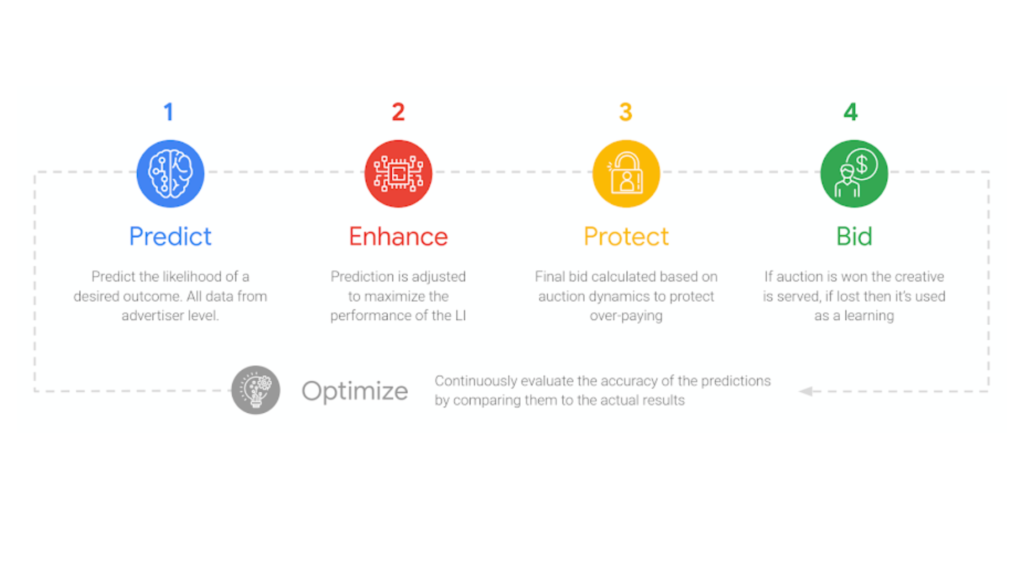
Definition:
Automated bidding strategies in Google Ads use sophisticated algorithms to optimize the bids for your ads automatically. These algorithms aim to achieve specific performance goals, such as maximizing the likelihood of clicks or conversions. This type of strategy is a prime example of Pay-Per-Click (PPC) automation, which saves time and enhances ad campaign performance for better return on investment.
Simple Explanation:
Automated bidding lets Google decide how much to bid for you, based on what you want to achieve. If you want more people to click on your ad or more customers to buy your product, Google’s algorithms will adjust your bids to help you reach those goals. This strategy saves you a lot of time because you don’t have to constantly tweak bids yourself. Plus, it helps your ads perform better.
Example:
Imagine you own an online bookstore and you’re running Google Ads to promote your latest collection of bestsellers. You want more people to visit your website and make purchases, but you don’t have the time to constantly adjust your bids for each keyword. This is where automated bidding comes in.
First, you choose an automated bidding strategy that aligns with your goal. Let’s say you want to maximize conversions, sales in this case. You select the “Maximize Conversions” strategy in Google Ads.
Google’s algorithm then takes over. It analyzes vast amounts of data, such as the times of day when people are most likely to buy books, the types of devices they use, and even the specific keywords that lead to sales. Based on this information, it adjusts your bids in real-time to maximize the number of conversions within your budget.
For example, if Google sees that people searching for “buy bestsellers online” are highly likely to make a purchase, it might increase the bid for this keyword. Conversely, if another keyword, like “cheap books,” isn’t leading to many sales, Google might lower the bid or even stop bidding on it altogether.
As a result, your ad spend is optimized without you having to lift a finger. You get more sales from your ads because the bidding is continuously adjusted to target the most promising opportunities.
3. Smart Bidding Strategies
Definition:
Smart Bidding is a subset of automated bidding strategies in Google Ads that focuses on optimizing for conversions or conversion value in real-time. This strategy leverages Google’s AI at each auction—referred to as “auction-time bidding” and considers multiple signals like device, location, and time of day to enhance the precision of each bid.
Simple Explanation:
Smart Bidding uses Google’s advanced AI to adjust your bids automatically in order to get the most conversions or the highest value from conversions. It works in real-time, taking into account various factors such as the device someone is using, their location, and the time of day, to make the most effective bid for each auction.
Example:
Let’s say you run an online store that sells handmade jewelry, and you want to increase your sales through Google Ads. You decide to use Smart Bidding to optimize your ad campaign because you want the AI to handle the bidding process and ensure you get the best results.
Firstly, you set your campaign’s goal, such as maximizing conversions (sales). With Smart Bidding, Google’s AI takes over the bidding process. Every time someone searches for keywords related to your products, the AI evaluates numerous factors in real-time, known as auction-time signals.
For example, if a user searches for “handmade silver rings” on their smartphone while being in a city where you’ve had a lot of sales, Google’s AI might decide to bid higher for this particular auction. It knows that users in that location, using that type of device, and searching at that specific time of day, are more likely to make a purchase based on historical data.
Conversely, if someone searches for “handmade jewelry ideas” late at night in a region where you haven’t had many sales, the AI might bid lower or not at all, recognizing that this search is less likely to lead to a conversion.
By using Smart Bidding, you benefit from the AI’s ability to make precise, data-driven decisions at the moment each auction happens. This means you spend less time managing bids and more time seeing improved results from your ad campaigns.
Budget
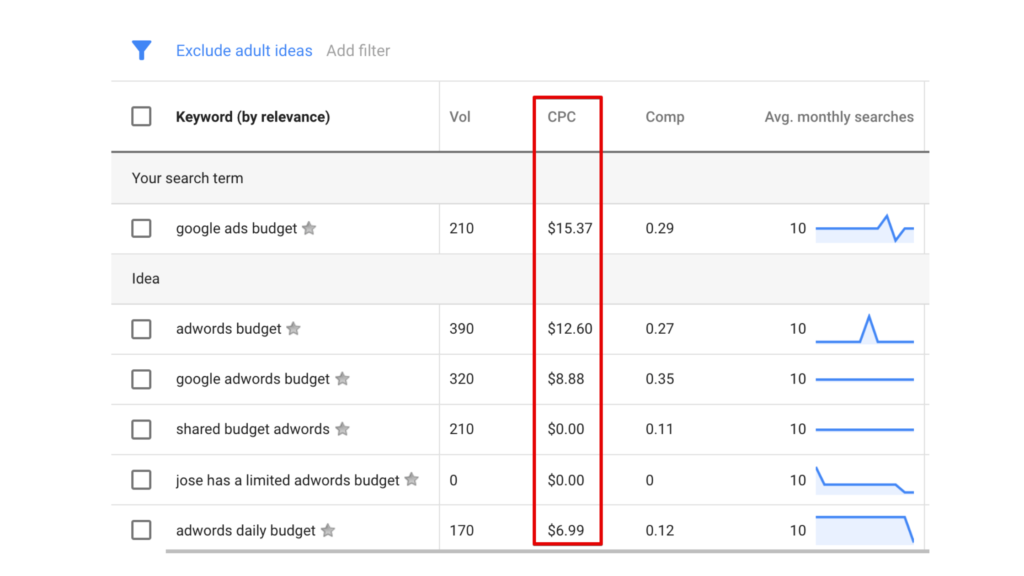
Definition:
In Google Ads, a budget is a Terminology that lets you specify the amount you want a campaign to spend each day. On any given day, the budget might overspend by up to twice the amount set for the campaign to account for fluctuations in impressions and clicks on your ads. However, over a calendar month, you won’t be charged more than 30.4 times your daily budget amount, ensuring you stay within your monthly limit.
Simple Explanation:
Your budget in Google Ads is the amount of money you decide to spend on your ads each day. Google might sometimes spend a bit more on a busy day, but it balances out so you don’t go over your monthly budget.
Example:
Imagine you own a small online bookstore, and you decide to run an ad campaign to attract more customers. You set your daily budget at $10. This means Google will aim to spend about $10 each day to show your ads.
Let’s say one day, there is a surge in people searching for books, and your ads get a lot of clicks. Google might spend up to $20 that day because it sees an opportunity to get more impressions and clicks. However, on another day when fewer people are searching for books, Google might only spend $5.
Despite these daily fluctuations, Google ensures that by the end of the month, your total spending doesn’t exceed 30.4 times your daily budget. So, if your daily budget is $10, the maximum you will spend in a month is $304.
This flexibility helps your ads to be shown when they are most likely to be effective, while still keeping your overall spending under control. For instance, during a major book release, the extra spending on that day could lead to more sales, making your ad budget work harder for you.
Branded Content
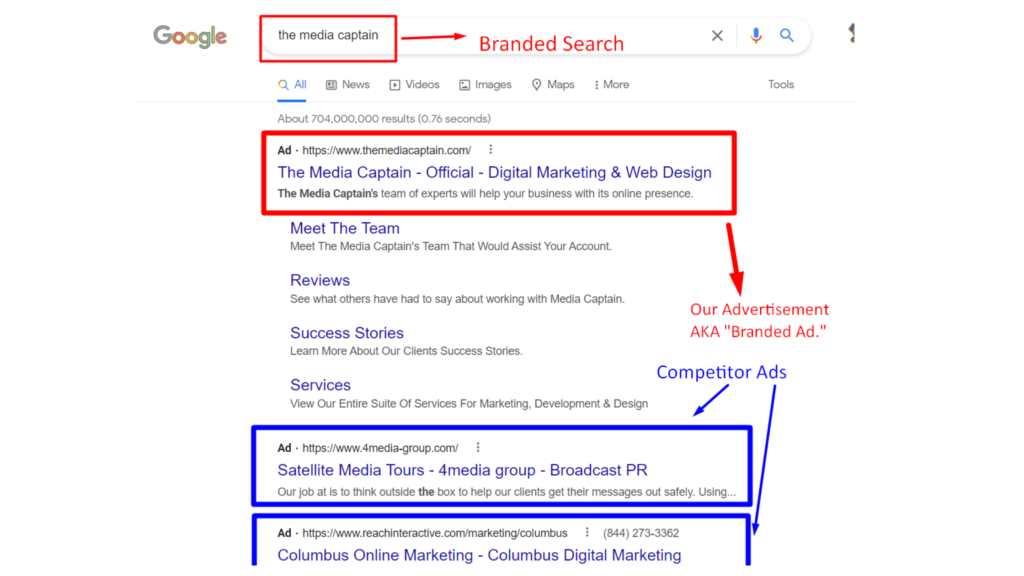
Definition:
Branded Content in Google Ads refers to content created in collaboration with an advertiser. The advertiser can request to link this content to their Google Ads account. If you agree to this link, the advertiser can access performance metrics of the content and target ads to viewers of your YouTube video through Google Ads.
Simple Explanation:
In simple terms, branded content is when you work with a brand to create content. If the brand wants to see how well the content is performing and use it in their ads, they can ask to link to your content. If you accept, they can then track how many people are watching and engaging with the content and use that data to show ads to the viewers.
Example:
Imagine you have a YouTube channel where you review tech gadgets. A smartphone company likes your reviews and partners with you to create a video about their new phone. They request to link this video to their Google Ads account. You accept the request. Now, the smartphone company can see how many people watched your video, how long they watched, and other engagement metrics. They can also show ads to people who watched your video, promoting other products or special offers.
Additionally, linking your branded content to an advertiser helps manage partnerships with brands, share organic video metrics, and increase the likelihood that advertisers will promote your content. However, it’s important to understand the terms of any agreement and ensure it aligns with your channel’s best interests before accepting a link request.
Content Suitability
Definition:
Content Suitability, also known as ‘Inventory Type,’ is an account-level setting that allows you to decide if you want your display ads shown alongside sensitive content. For instance, you can prevent your ads from appearing on web pages with profanity or other sensitive material.
The options available are
- Limited Inventory
- Standard Inventory
- Expanded Inventory
Simple Explanation:
Content Suitability is a feature in Google Ads that lets you control where your ads appear. You can choose whether you want your ads to show on web pages with sensitive content, such as profanity, or keep them in more family-friendly environments
Example:
Imagine you run a family-friendly travel agency that specializes in vacations for families with young children. You want to advertise your services through Google Ads, but you are concerned about your ads appearing on websites with inappropriate or sensitive content.
By using the Content Suitability settings, you can decide where your ads will be shown. If you choose ‘Limited Inventory,’ your ads will only appear on websites that are very safe and free from sensitive content. This is the best choice if you want to ensure your ads are always shown in family-friendly environments.
Alternatively, if you select ‘Standard Inventory,’ your ads will appear on a broader range of websites, which might include some mildly sensitive content but are still generally appropriate for most audiences.
If you opt for ‘Expanded Inventory,’ your ads can appear on almost any site, including those with more sensitive content. This option allows for the widest reach but with less control over the content context.
For example, choosing ‘Limited Inventory’ might mean your travel agency ads appear on parenting blogs and family travel forums, avoiding websites with violent or adult themes. This way, you maintain a brand image that aligns with your values and resonates with your target audience.
Conversion and Tracking
Definition:
A conversion in Google Ads is any action that is valuable to your organization. Conversion tracking allows you to measure the number of people who perform significant actions on your website, such as viewing important pages (like thank you pages), making phone calls using a Google forwarding number, downloading apps, completing actions within an app, and even offline conversions. Google Ads provides tools to track these conversions directly or import data from Google Analytics.
Simple Explanation:
A conversion is a specific action taken by a user that benefits your business, like making a purchase, signing up for a newsletter, or calling your company. Conversion tracking helps you see how many people are completing these actions because of your ads.
Example:
Let’s say you run an online clothing store, and you want to know how many people are buying items after clicking on your Google Ads. First, you set up conversion tracking in Google Ads to monitor these sales.
1. Setting Up Conversion Tracking
You install a tracking code on your website that triggers whenever someone completes a purchase. This could be when they reach the “Thank You” page after buying an item.
2. Monitoring Conversions
Over a week, you notice that your ad has received 1,000 clicks. Out of these clicks, 50 users make a purchase. This means you have 50 conversions.
3. Analyzing Data
With this information, you see that your ad is effective because it leads to valuable actions purchases, in this case. You can also track other actions, like if people called your customer service using a special number provided in the ad or if they downloaded your store’s app.
4. Using the Data
Suppose you also notice that users who click on ads for “Summer Sale” items are more likely to convert compared to other ads. This insight might prompt you to invest more in promoting your summer collection. Alternatively, you could see that conversions spike on weekends. This could lead you to adjust your ad scheduling to maximize visibility during these times.
By using conversion tracking in Google Ads, you can better understand which ads are driving valuable actions for your business. This allows you to refine your strategies, focus on high-performing ads, and ultimately get more value from your advertising budget.
Conversion Optimization
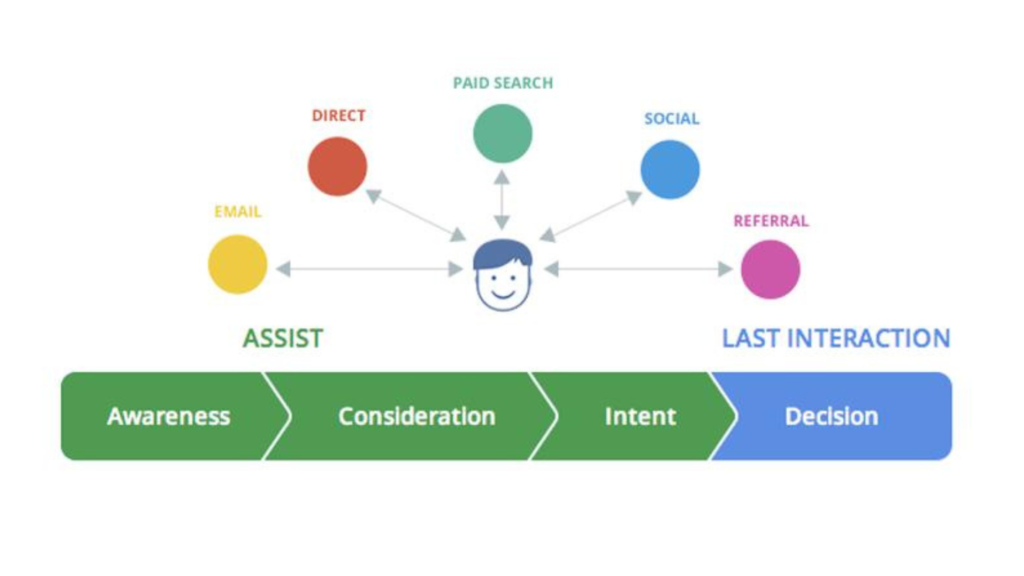
Definition:
Conversion optimization in Google Ads Terminology is the process of improving your campaigns and landing pages with the goal of increasing conversions. This involves using Google Ads conversion tracking and other tools, such as A/B testing platforms, to measure performance and make data-driven adjustments. Conversion rate optimization focuses on increasing the percentage of users who perform a desired action on a website, such as making a purchase, clicking ‘add to cart’, or filling out a form.
Simple Explanation:
Conversion optimization means tweaking your ads and website to get more people to do what you want, like buy something or sign up for a newsletter. It’s about making your ads and web pages better so more visitors turn into customers. While conversion rate measures your website’s current performance, conversion optimization focuses on continuously improving that rate through data-driven testing and iterative improvements.
Example:
Imagine you run a subscription-based fitness app and want more visitors to sign up for a monthly plan after clicking on your Google Ads. Here’s how you might use conversion optimization
1. A/B Testing
You decide to run an A/B test on your landing page. You create two versions: one highlighting user testimonials and success stories, and another emphasizing the cost savings of a monthly subscription versus a pay-per-workout model. Half of the visitors see the page with testimonials, and the other half see the page with cost savings.
2. Measuring Results
After the test, you find that the page highlighting cost savings has a higher conversion rate. More visitors who see the cost savings information sign up for the monthly plan.
3. Making Improvements
Based on these results, you update your landing page to prominently feature the cost savings of subscribing monthly. Additionally, you notice that some visitors drop off at the payment stage, so you streamline the payment process to make it quicker and more user-friendly.
4. Continuous Optimization
You continue to test different elements, such as ad copy, images, and call-to-action buttons. For example, you test whether “Start Your Free Trial” or “Join Now” works better to encourage sign-ups. You also experiment with offering a limited-time discount to see if it boosts conversions.
By continuously analyzing and improving your ads and landing pages, you optimize for conversions. This means you make changes that help turn more visitors into paying subscribers, ultimately increasing your revenue and making your advertising more effective.
Conversion Value
Definition
Conversion value in Google Ads Terminology is the amount a conversion is worth to your business. This value can be defined during the conversion setup, within the tracking code when using Google Ads conversion tracking, or based on the transaction amount when imported from Google Analytics. Conversion value is a numerical value that advertisers assign to specific conversions, representing the impact each conversion has on the business.
Simple Explanation:
Conversion value means assigning a monetary worth to different actions people take on your website after clicking your ad. This helps you understand which actions are most valuable to your business.
Example:
Imagine you run an online electronics store, and you want to know how valuable different customer actions are so you can allocate your advertising budget effectively. Here’s how you might use conversion value
1. Setting Up Conversion Tracking
First, you set up conversion tracking in Google Ads for various actions on your website, such as product purchases, newsletter sign-ups, and adding items to the cart.
2. Assigning Values
You assign different values to each action based on its importance to your business.
For example:
A product purchase might be worth $100. Signing up for the newsletter might be worth $10, since these users can be marketed to later. Adding an item to the cart might be worth $5, indicating a high intent to purchase.
3. Tracking Conversions
When a customer clicks on your Google Ad and completes any of these actions, the assigned value is recorded. For instance, if a customer buys a product worth $100, that value is captured in your conversion data.
4. Analyzing Data
Over time, you analyze your conversion data. You notice that while many people are signing up for the newsletter, those who purchase products contribute much more to your overall revenue. You also observe that customers who add items to their cart but don’t complete the purchase still indicate a strong interest and can be targeted with remarketing ads.
5. Optimizing Campaigns
Based on these insights, you decide to increase your ad budget for campaigns targeting product purchases, as they have the highest conversion value. You also create a remarketing campaign for customers who added items to their cart but didn’t complete the purchase, encouraging them to finalize their purchase with a special discount.
6. Continuous Improvement
You continuously monitor and adjust your conversion values as you gather more data. For example, if you launch a new high-value product, you might assign it a higher conversion value compared to other products. dditionally, you test different ad copy and landing pages to see if they increase the conversion value by driving more high-value actions.
By assigning and tracking conversion values, you can clearly see which customer actions are most profitable for your business. This allows you to focus your advertising efforts on the actions that generate the most value, optimizing your campaigns for maximum return on investment.
Cost-per-Acquisition (CPA)

Definition
Cost-per-acquisition (CPA) is a Terminology used in Google Ads to measure the average cost incurred by an advertiser for each conversion action. It represents the amount you are willing to spend to acquire a customer or achieve a specific goal, such as a sale, lead, or app download. CPA is calculated by dividing the total cost of your advertising campaign by the number of conversions generated.
Simple Explanation with Example:
In simpler terms, CPA tells you how much it costs you on average to gain a customer or achieve a desired outcome through your Google Ads campaigns. For instance, if you spent $500 on a campaign and it resulted in 50 conversions (sales or leads), your CPA would be $10 per conversion ($500 / 50 conversions). This metric helps advertisers assess the effectiveness and efficiency of their advertising spend. Lower CPA values indicate more cost-effective campaigns, while higher CPAs may require adjustments in targeting, bidding, or ad messaging to improve performance and profitability.
CPA is crucial for optimizing campaigns because it directly ties advertising costs to tangible results, allowing businesses to allocate budgets more effectively and maximize return on investment (ROI). By monitoring and optimizing CPA, advertisers can refine their strategies to attract more qualified leads or customers within their budget constraints.
Cost-per-Click (CPC)
Definition
Cost-per-click (CPC) is a fundamental Terminology in Google Ads that represents the amount an advertiser pays for each click on their advertisement. Advertisers set CPC bids, specifying the maximum amount they are willing to pay for a single click on their ad. CPC is a key factor in Google Ads auctions, where ads compete based on their bids and ad quality to appear in search results or on other Google platforms.
Simple Explanation with Example:
In simpler terms, CPC is the price you agree to pay for each click on your Google Ads. For example, if you set a CPC bid of $1.50 for a keyword, you will pay up to $1.50 every time someone clicks on your ad. The actual amount you pay per click can vary depending on factors like competition from other advertisers and the quality of your ad.
Let’s say you run a campaign promoting a new line of sneakers with a CPC bid of $2. If a user searches for “buy running shoes” and clicks on your ad, you will be charged up to $2 for that click. CPC is crucial because it directly influences your ad’s visibility and cost-effectiveness. Advertisers often adjust CPC bids based on performance data to maximize clicks within their budget and achieve their advertising goals efficiently
Cost-per-Thousand-Impressions (CPM)

Definition
Cost-per-thousand-impressions (CPM) is a bidding strategy in Google Ads where advertisers pay for every 1,000 times their ad is displayed, regardless of whether users click on it or not. CPM is commonly used by advertisers aiming to maximize their ad’s visibility and increase brand awareness rather than focusing on direct clicks or conversions. Google Ads implements viewable CPM bidding, which ensures advertisers only pay when their ad is viewable to users.
Simple Explanation with Example:
In simpler terms, CPM refers to the cost an advertiser pays for every 1,000 times their ad is shown to users, regardless of whether anyone clicks on it. For instance, if you set a CPM bid of $10 and your ad is displayed 5,000 times, you will be charged $50 ($10 per thousand impressions x 5).
Imagine you run a campaign to promote a new line of eco-friendly products. Your goal is to increase awareness among environmentally conscious consumers. By using CPM bidding, you ensure your ad appears frequently across relevant websites and apps. This way, you pay based on the number of times your ad is seen, which helps in spreading awareness about your products without focusing on immediate clicks or conversions.
CPM bidding is advantageous for advertisers looking to boost brand visibility and reach a broader audience effectively. It allows them to allocate their advertising budget towards maximizing impressions and enhancing brand recognition across various platforms and placements.
Click-Through Rate (CTR)
Definition
Click-through rate (CTR) in Google Ads is a Terminology that measures the ratio of clicks to impressions for your ads. It is expressed as a percentage and indicates how often people who see your ad end up clicking on it. CTR is an essential metric because it provides insights into the effectiveness of your ad copy, targeting, and overall campaign performance.
Simple Explanation and Example
In simpler terms, CTR tells you how often users click on your ad after seeing it. For example, if your ad receives 100 clicks from 1,000 impressions, your CTR would be 10%
100 clicks / 1,000 impressions * 100
Let’s say you’re running an online campaign for a new fitness app. Your ad appears on fitness websites and apps, generating 10,000 impressions over a week. Out of those impressions, 500 users click on your ad to learn more about your app. To calculate your CTR, you divide the number of clicks (500) by the number of impressions (10,000), resulting in a CTR of 5%.
CTR is crucial because it indicates how engaging and relevant your ad is to your target audience. A higher CTR generally means your ad is resonating well with users, leading to more clicks and potentially more conversions. Advertisers often use CTR to assess ad performance, optimize campaigns, and refine ad creatives to attract more clicks and improve overall campaign effectiveness.
Experiment in Google Ads
Definition
An experiment in Google Ads is a Terminology feature that enables advertisers to test changes in their campaigns, ad groups, or other settings to assess their impact on performance. It allows advertisers to create controlled tests by comparing the performance of an experimental version (often referred to as a draft) against the original version (known as the control).
Simple Explanation and Example
In simpler terms, experiments in Google Ads let you make changes to your advertising strategy in a controlled manner to see if they improve results. Here’s how it works:
Imagine you’re managing a Google Ads campaign for a new line of eco-friendly products. You want to test whether using different ad copy increases click-through rates (CTR). Here’s how you would set up an experiment:
1. Create a Draft
You start by creating a draft within your Google Ads account. This draft contains the changes you want to test, such as new ad copy variations.
2. Apply Changes
Next, you apply the changes (new ad copy) to your draft that you want to test against your existing ads.
3. Launch the Experiment
Once you’re ready, you launch the experiment. Google Ads will now randomly show your experimental ads alongside your original ads to users searching for relevant keywords.
4 Compare Performance
During the experiment, Google Ads will collect data on how each version (experimental and original) performs. You can then compare metrics like CTR, conversion rates, and cost-per-acquisition (CPA) between the two
5. Analyze Results
After running the experiment for a specified period, you analyze the results. If the experimental version outperforms the original (control), you can consider applying those changes permanently to improve overall campaign performance.
Experiments are valuable because they allow advertisers to make data-driven decisions based on real-world performance data. They help in optimizing campaigns, improving ad effectiveness, and refining advertising strategies to achieve better results in Google Ads.
Google Ads Editor
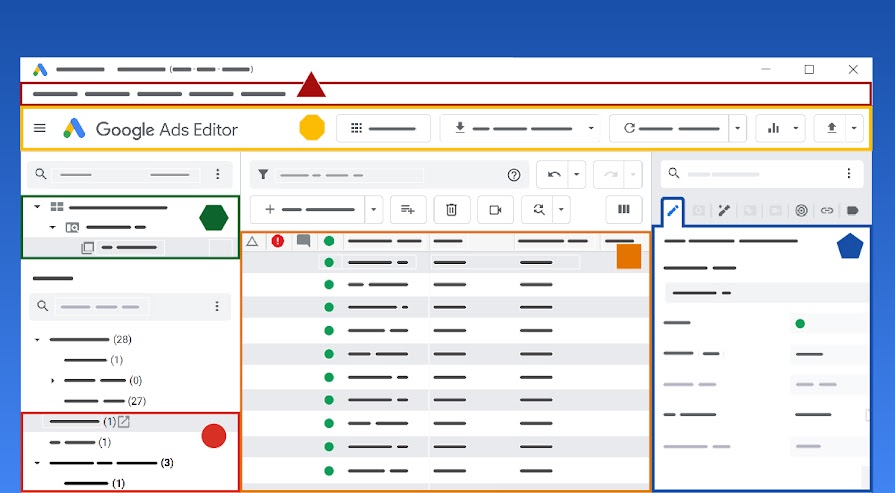
Definition
Google Ads Editor is a desktop application developed by Google that provides advertisers with a comprehensive toolset to manage their Google Ads campaigns offline. It allows users to download their entire Google Ads account, make bulk changes or edits to campaigns, ad groups, ads, and keywords, and then upload these modifications back to their live Google Ads account.
Simple Explanation and Example
In simpler terms, Google Ads Editor is a Terminology that is a powerful toolbox for managing your advertising campaigns on Google.
Imagine you are running multiple campaigns across different regions and products on Google Ads. Here’s how Google Ads Editor can help:
1. Download Your Account
You start by downloading your entire Google Ads account into Google Ads Editor. This includes all campaigns, ad groups, ads, and keywords associated with your account.
2. Make Bulk Changes
Using Google Ads Editor, you can make extensive changes offline. For example, you might want to update ad copy, adjust keyword bids, or change targeting settings across multiple campaigns simultaneously.
3 Preview and Verify Changes
After making edits, you can preview how these changes will look once applied. This helps ensure accuracy and consistency across your campaigns.
4. Upload Changes
Once satisfied with the modifications, you upload the changes back to your live Google Ads account directly from Google Ads Editor. This process saves time and minimizes the chance of errors compared to making individual changes within the online interface.
5. Manage Campaigns Efficiently
Google Ads Editor is particularly useful for advertisers managing large-scale campaigns or frequent updates. It provides a centralized platform to streamline campaign management, improve workflow efficiency, and maintain campaign consistency across various advertising initiatives.
Google Analytics
Definition:
Google Analytics is a digital analytics tool provided by Google that tracks and reports website traffic, providing insights into user behavior, acquisition channels, conversions, and more.
Simple Explanation and Example
Google Analytics is a powerful tool that helps website owners understand how people interact with their websites. It tracks things like how many people visit your site, where they come from (like Google search or social media), what they do on your site (like clicking on links or watching videos), and whether they complete actions you want them to take (like making a purchase or signing up for a newsletter). It gives you data and insights that can help you improve your website and make better decisions about your online marketing efforts.
For example, if you run an online store, Google Analytics can tell you how many visitors bought something after seeing your ads. It’s a powerful tool to see what’s working on your site and what you can improve to attract more customers.
Keyword Planner
Definition:
Keyword Planner in Google Ads is a powerful tool designed to assist advertisers in researching and selecting the best keywords for their search campaigns. It offers various functionalities that help in identifying relevant keywords and planning ad campaigns effectively.
Simple Explanation and Example:
Simply put, the Keyword Planner helps you discover new keywords by suggesting relevant terms that users might search for. For instance, if you’re running a campaign for “digital marketing courses,” the tool can provide related keywords like “online marketing courses,” “SEO training,” or “social media marketing classes.” It also gives estimates on search volume, potential clicks, and cost-per-click for these keywords.
By using the Keyword Planner, advertisers can refine their keyword lists based on search trends and audience behavior, ensuring their ads are targeting the right audience with the most effective keywords. This tool is particularly useful for optimizing ad campaigns to reach potential customers more efficiently and drive better results in Google Ads.
Performance Planner
Definition:
Performance Planner in Google Ads is a powerful tool and Terminology designed to help advertisers strategically plan their advertising budget and predict how adjustments to campaigns could influence performance metrics. It allows users to forecast potential outcomes based on different scenarios, such as modifying daily budgets, changing bidding strategies, or refining audience targeting.
Example:
if an advertiser wants to estimate the impact of doubling their ad spend on a specific campaign, they can use Performance Planner to predict the potential increase in clicks, conversions, or other key metrics. This enables advertisers to make data-driven decisions to optimize their campaigns and achieve better overall performance in Google Ads.
Reach Planner in Google Ads
Definition:
Reach Planner is a planning tool within Google Ads is a Terminology that specifically assists advertisers in forecasting the reach, views, and conversions of video campaigns across YouTube and its partner sites and apps. It enables advertisers to create detailed media plans based on metrics like Unique Reach, Views, and Conversions, providing insights into the potential impact of their video ads before they are launched.
Simple Explanation and Example:
Reach Planner is a tool provided by Google Ads is a Terminology that helps advertisers plan their video campaigns on YouTube and other video partner platforms. It allows advertisers to predict how many people their video ads will reach, how many views they might get, and the potential impact on conversions. By using Reach Planner, advertisers can make informed decisions about their advertising budgets and strategies before launching their campaigns.
Imagine a company planning to launch a new promotional video campaign on YouTube to increase brand awareness. Using Reach Planner, they can input parameters such as budget, target audience demographics, and campaign objectives. The tool then generates forecasts, estimating metrics such as how many unique users the ad will reach, how many views it might accumulate, and the anticipated conversions resulting from these views. This allows the company to make informed decisions about their campaign strategy, ensuring they allocate resources effectively to achieve their marketing goals.
Quality Score
Definition:
Google Ads Quality Score is a crucial Terminology that evaluates the effectiveness and relevance of your ads to users searching for specific keywords. It plays a significant role in determining where your ads appear on search engine results pages (SERPs) and how much you pay per click (CPC).
Simple Explanation
Simply put, Quality Score reflects how well your ads meet the needs of users searching for your targeted keywords. It ranges from 1 to 10, with higher scores indicating more relevant and effective ads. A higher Quality Score can lead to benefits such as better ad placements, lower CPCs, and improved ROI on your advertising budget.
Example:
If your Quality Score for a keyword is 8, your ad is likely to rank higher and cost less per click compared to ads with lower scores. This is because Google rewards ads that provide a positive user experience, with factors like expected click-through rate (CTR), ad relevance, and landing page experience all contributing to your Quality Score.
Therefore, optimizing your campaigns to improve Quality Score involves choosing relevant keywords, crafting compelling ad copy, and ensuring your landing pages align seamlessly with user expectations. This holistic approach not only enhances your ad performance but also maximizes the value you get from your Google Ads investment.
Optimization Score
Definition:
Optimization Score in Google Ads Terminology is an estimate of how well your account is set to perform. This score ranges from 0% to 100%, with 100% indicating that your account is performing at its full potential. The score is calculated based on a variety of factors and comes with a list of recommendations to help improve each campaign.
Simple Explanation
In simpler terms, the Optimization Score tells you how well your Google Ads campaigns are set up and what you can do to make them even better. For example, if your Optimization Score is 75%, it means there is room for improvement, and by following Google’s suggestions, you can boost your campaigns’ effectiveness.
Example
Let’s say you have a Google Ads campaign for an online store selling shoes. Your current Optimization Score is 70%. Google Ads might suggest increasing your budget for high-performing keywords, improving your ad copy, or adding new keywords that are relevant to your products. By implementing these recommendations, your Optimization Score can increase, leading to better ad placements and more clicks, which can ultimately drive more sales.
Shared Library
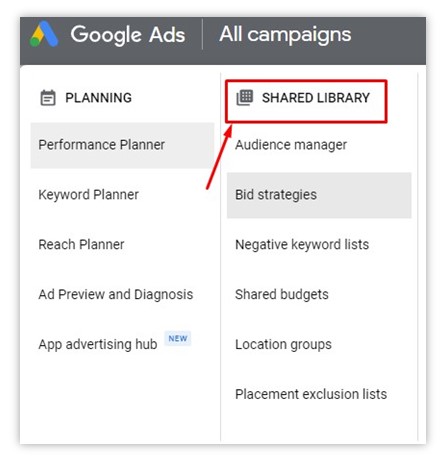
Definition
Shared Library in Google Ads is a feature that allows you to implement changes across multiple campaigns, centralize settings and assets, and manage shared sets, audiences, and other essential elements in one place. Essentially, it helps you efficiently manage and apply common settings or lists to various campaigns, saving you time and ensuring consistency.
Simple Explanation
In simpler terms, the Shared Library is like a toolbox where you keep all the tools you need for your ad campaigns. For instance, if you have a set of keywords or audiences you use in multiple campaigns, you can store them in the Shared Library. Then, instead of adding them to each campaign individually, you can quickly apply them from the library.
Example
Imagine you run an online store selling different types of electronics. You have separate campaigns for smartphones, laptops, and accessories. You want to exclude certain keywords that are irrelevant to all your campaigns, like “free” or “cheap.” Instead of adding these negative keywords to each campaign one by one, you can create a negative keyword list in the Shared Library. Once created, you can easily apply this list to all your campaigns with just a few clicks.
Furthermore, the Shared Library can be used for managing budgets. Suppose you have a fixed budget for all your electronic campaigns. You can create a shared budget in the Shared Library, and this budget will be automatically distributed across all your campaigns, ensuring you don’t overspend on any single campaign.
Return on Advertising Spend (ROAS)
Definition
Return on Advertising Spend (ROAS) in Google Ads is a Terminology that measures the effectiveness of your advertising campaign by dividing the total revenue generated by the total amount spent on ads. It indicates how much revenue you earn for every dollar spent on advertising.
Simple Explanation
In simple words, ROAS tells you how profitable your ads are. It helps you understand if the money you are spending on ads is bringing in enough revenue. For instance, if you run an online store and spend $100 on ads, you want to know how much money you made from those ads. If you made $300 in sales, your ROAS is 300%, meaning you earned three times what you spent.
Example
Imagine you own a small business selling handmade jewelry online. You decide to run a Google Ads campaign to attract more customers. You set a budget and spend $1,000 on ads over a month. At the end of the month, you check your sales data and find out that the ads helped you generate $4,000 in revenue. To calculate your ROAS, you divide your total revenue ($4,000) by your total ad spend ($1,000).
ROAS=Total Revenue/Total Ad Spend
ROAS=4000/1000=4
So, your ROAS is 4, or 400%. This means that for every dollar you spent on ads, you earned four dollars in revenue.
Tracking Template

Definition
Tracking Template in Google Ads is a Terminology allows you to pass additional details through to your landing page. Parameters used in Tracking Templates can be used for reporting or customizing the user experience on your website. A tracking template is a place where you put URL tracking information. A tracking template at the ad group, campaign, or account level applies to all of the ads in the corresponding ad group, campaign, or account.
Simple Explanation
In simpler terms, a Tracking Template is like a tag you attach to your ad’s URL. This tag collects information about the click, such as which ad or keyword the click came from. For example, if you want to know how many people clicked on your ad from a specific campaign, you can use a tracking template to track that information.
Example
Imagine you own an online bookstore and you run multiple Google Ads campaigns to promote different categories of books, such as fiction, non-fiction, and children’s books. You want to track which campaign generates the most clicks and sales. To do this, you can create a Tracking Template with specific parameters for each campaign.
For instance, you might set up a tracking template like this:
“{lpurl}?campaign={campaignid}&adgroup={adgroupid}&keyword={keyword}”
In this template:
- {lpurl} represents the final URL of your landing page.
- {campaignid} will capture the ID of the campaign.
- {adgroupid} will capture the ID of the ad group.
- {keyword} will capture the keyword that triggered the ad.
If someone clicks on your ad for fiction books, the URL they are taken to might look something like this:
“www.yourbookstore.com/fiction?campaign=123&adgroup=456&keyword=fiction”
This URL tells you that the click came from the fiction campaign, the specific ad group within that campaign, and the keyword “fiction.” By analyzing these parameters, you can determine which campaigns and keywords are performing best, allowing you to optimize your advertising strategy.
By Yashika N Choudhary | Intern Digital Marketer at Inspyr

